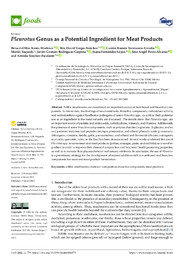Por favor, use este identificador para citar o enlazar este ítem:
https://hdl.handle.net/11000/31794Registro completo de metadatos
| Campo DC | Valor | Lengua/Idioma |
|---|---|---|
| dc.contributor.author | Torres Martínez, Brisa del Mar | - |
| dc.contributor.author | Vargas Sánchez, Rey David | - |
| dc.contributor.author | Torrescano-Urrutia, Gastón Ramón | - |
| dc.contributor.author | Esqueda, Martin | - |
| dc.contributor.author | Rodriguez-Carpena, Javier-German | - |
| dc.contributor.author | Fernandez-Lopez, Juana | - |
| dc.contributor.author | Pérez-Alvarez, José Angel | - |
| dc.contributor.author | Sánchez-Escalante, Armida | - |
| dc.contributor.other | Departamentos de la UMH::Tecnología Agroalimentaria | es_ES |
| dc.date.accessioned | 2024-03-22T08:20:45Z | - |
| dc.date.available | 2024-03-22T08:20:45Z | - |
| dc.date.created | 2022-03-08 | - |
| dc.identifier.citation | Foods 2022, 11(6), 779 | es_ES |
| dc.identifier.issn | 2304-8158 | - |
| dc.identifier.uri | https://hdl.handle.net/11000/31794 | - |
| dc.description.abstract | Edible mushrooms are considered an important source of nutritional and bioactive compounds. In this review, the findings of macronutrients, bioactive compounds, antioxidant activity, and antimicrobials against foodborne pathogens of some Pleurotus spp., as well as their potential use as an ingredient in the meat industry are discussed. The results show that Pleurotus spp. are an important source of proteins and amino acids, carbohydrates, minerals, and vitamins. Additionally, the presence of some bioactive components, such as polysaccharides (α-glucans, β-glucans, and so on), proteins/enzymes and peptides (eryngin, pleurostrin, and others) phenolic acids (p-coumaric, chlorogenic, cinnamic, ferulic, gallic, protocatechuic, and others) and flavonoids (chrysin, naringenin, myricetin, quercetin, rutin, or the like) has been demonstrated. Several works evidenced the use of Pleurotus spp. in some meat and meat products (patties, sausages, paste, and suchlike) as a novel ingredient in order to improve their chemical composition and functional health promoting properties, as well as to increase their physicochemical and sensory attributes. In conclusion, the use of Pleurotus is a promissory strategy for the development of natural additives rich in nutritional and bioactive components for meat and meat product formulation | es_ES |
| dc.format | application/pdf | es_ES |
| dc.format.extent | 13 | es_ES |
| dc.language.iso | eng | es_ES |
| dc.publisher | MDPI | es_ES |
| dc.rights | info:eu-repo/semantics/openAccess | es_ES |
| dc.rights | Attribution-NonCommercial-NoDerivatives 4.0 Internacional | * |
| dc.rights.uri | http://creativecommons.org/licenses/by-nc-nd/4.0/ | * |
| dc.subject | Edible mushrooms | es_ES |
| dc.subject | Chemical composition | es_ES |
| dc.subject | Bioactive compounds | es_ES |
| dc.subject | Meat products | es_ES |
| dc.subject.other | CDU::6 - Ciencias aplicadas::66 - Ingeniería, tecnología e industria química. Metalurgia::663/664 - Alimentos y nutrición. Enología. Aceites. Grasas | es_ES |
| dc.title | Pleurotus Genus as a Potential Ingredient for Meat Products | es_ES |
| dc.type | info:eu-repo/semantics/article | es_ES |
| dc.relation.publisherversion | https://doi.org/10.3390/foods11060779 | es_ES |

Ver/Abrir:
Pleurotus Genus as a Potential Ingredient for Meat Products.pdf
6,22 MB
Adobe PDF
Compartir:
 La licencia se describe como: Atribución-NonComercial-NoDerivada 4.0 Internacional.
La licencia se describe como: Atribución-NonComercial-NoDerivada 4.0 Internacional.
.png)